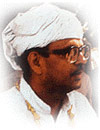

 |  |
 Apart from choosing an emotive issue of corruption, V.P. Singh also fashioned a consummate political strategy for isolating Rajiv and Congress. He first joined together with all those Congressmen who had become estranged with Rajiv for one reason or another. Among these was Arif Mohammad Khan, a young secular Muslim leader considered close to Rajiv. Arif had gained instant fame by openly supporting the Supreme Court judgement in Shah Bano case. Apart from choosing an emotive issue of corruption, V.P. Singh also fashioned a consummate political strategy for isolating Rajiv and Congress. He first joined together with all those Congressmen who had become estranged with Rajiv for one reason or another. Among these was Arif Mohammad Khan, a young secular Muslim leader considered close to Rajiv. Arif had gained instant fame by openly supporting the Supreme Court judgement in Shah Bano case.Arun Nehru, the estranged cousin whom Rajiv had edged out when he seemed to be becoming too powerful and inquisitive as Minister of State for Home, joined Arif in the wilderness. V.P.Singh, Arif, and Arun Nehru, joined by Ram Dhan, V.C. Shukla, Satpal Malik and other Congress dissidents, formed the Jan Morcha, or People’s Front on 2nd October 1987. With this as the core, V.P. Singh began to build an anti-Rajiv political bloc. He placated the left parties by calling them his natural allies and issuing statements against communalism, but made sure he had the BJP on his side by speaking from their platform and maintaining close links with Atal Behari Vajpayee and Lal Krishna Advani. However, more than V.P. Singh’s strategy, it was the inherent anti-Congressism of the left and the BJP that brought them to support V.P. Singh. His resounding victory in the Allahabad by-election in June 1988 against Congress, in which the Bofors gun had become the unofficial campaign symbol, had convinced them that he was the answer to their anti-Congress prayers. The feeling among the left and V.P. Singh was that, as in 1977-79, BJP would not be able to gain much as it did not have any independent strength. BJP, on the other hand, went along, often swallowing insults that a party with less discipline would have found impossible to get its cadre to tolerate, in the conviction that the dislodging of Congress was a necessary step on its road to power. The association with left and secular forces gave it the credibility it lacked by removing the stigma of communalism that had ensured it remained on the fringes of Indian politics. BJP increased its tally from 2 in 1984 to 86 in 1989, and this jump put it on the path to power, which it achieved in 1998. The strategy for opposition unity was conceived as a three-stage process. The first stage was the unity of centrist non-Congress secular national parties, the second the formation of a National Front of all non-left secular parties, regional and national, and the third the seat adjustments with left parties and BJP. The second stage was completed first, wjth the National Front of seven parties being formed on 6 August 1988. On 11 October 1988, the birthday of Jayaprakash Narayan, Janata Dal was formed with the merger of the Jan Morcha, Congress(S), Janata and Lok Dal. |
Copyright ©2000 indiansaga.info. All rights reserved.
By using this service, you accept that you won't copy or use the data given in this website for any commercial purpose.
The material on indiansaga.info is for informational & educational purpose only.
This site is best viewed at 800 X 600 picture resolution.